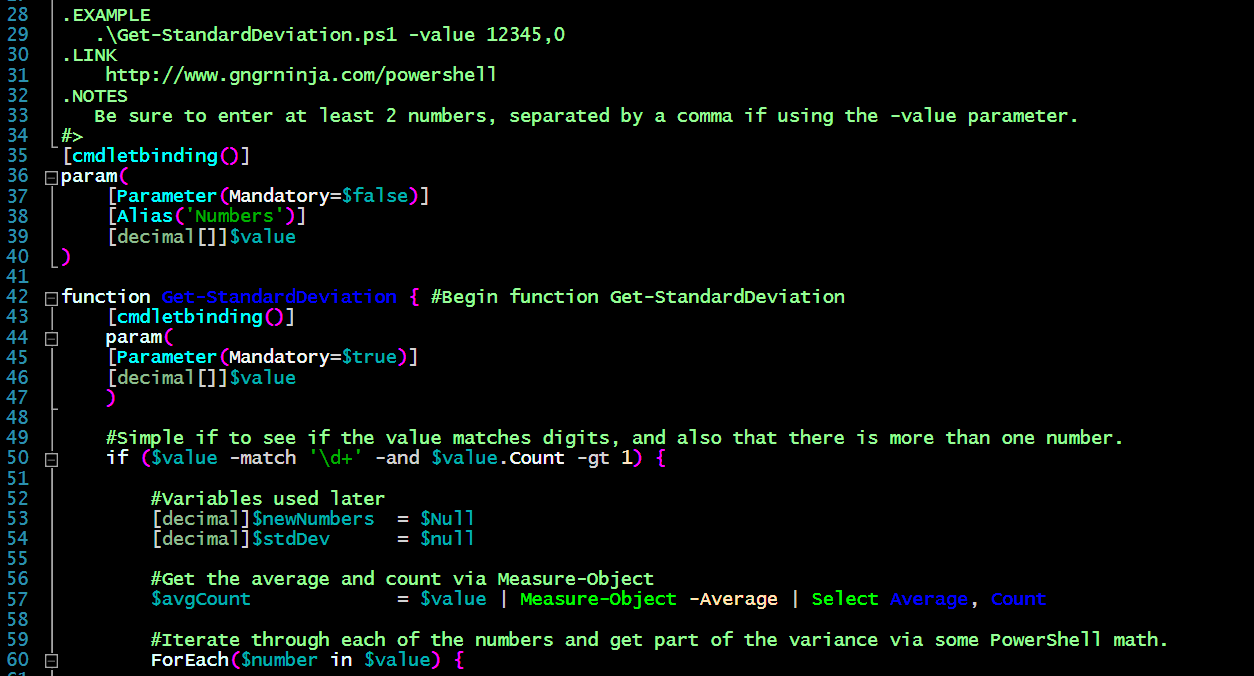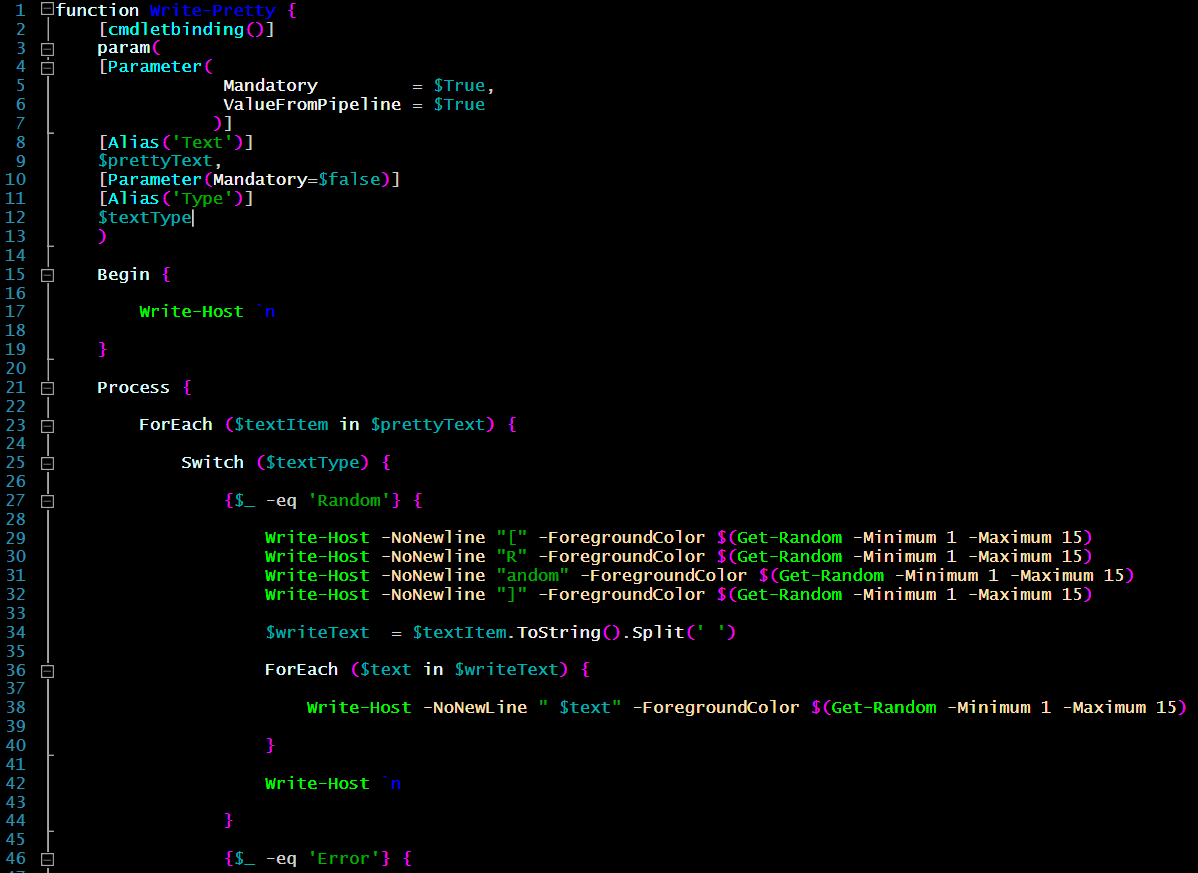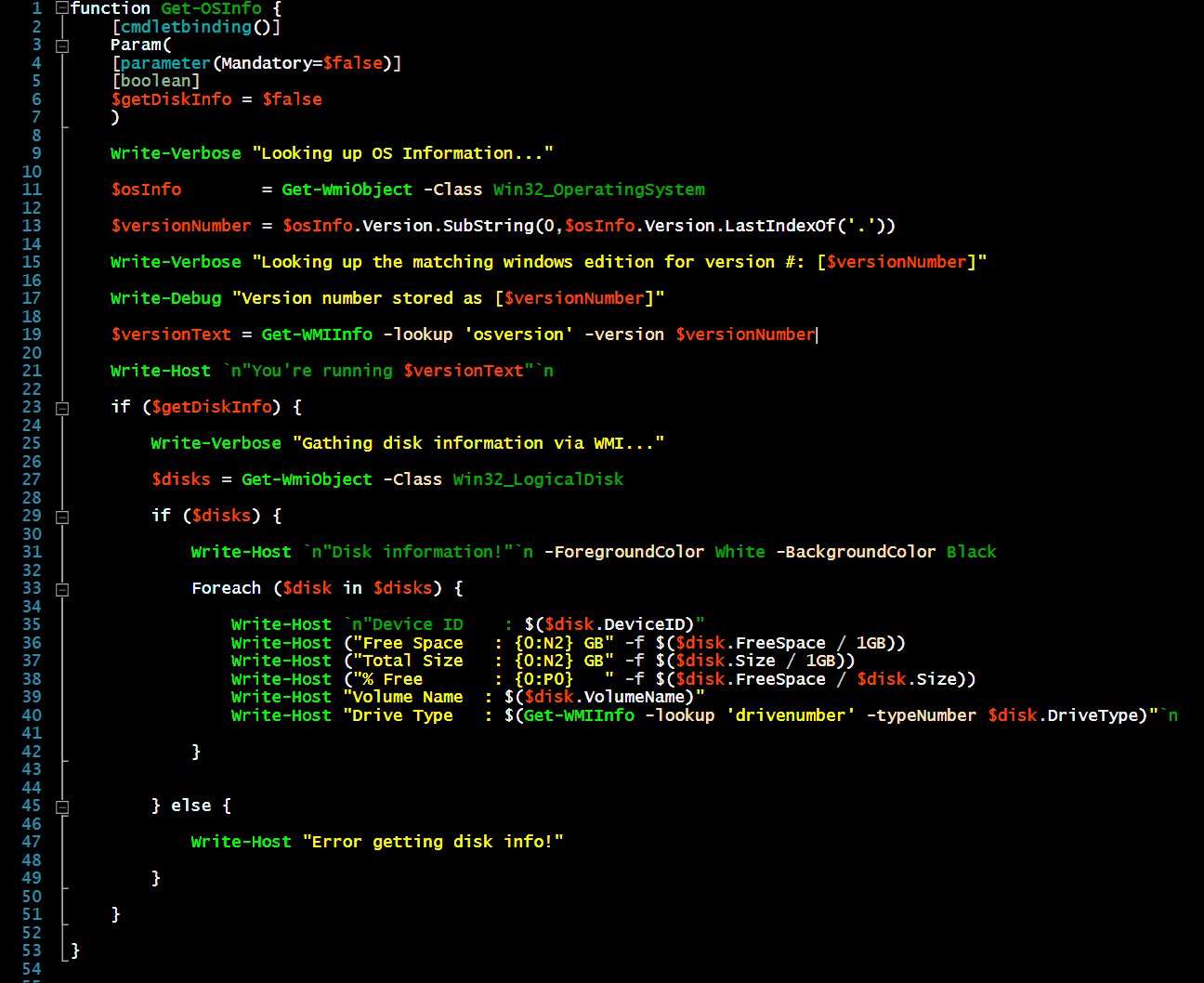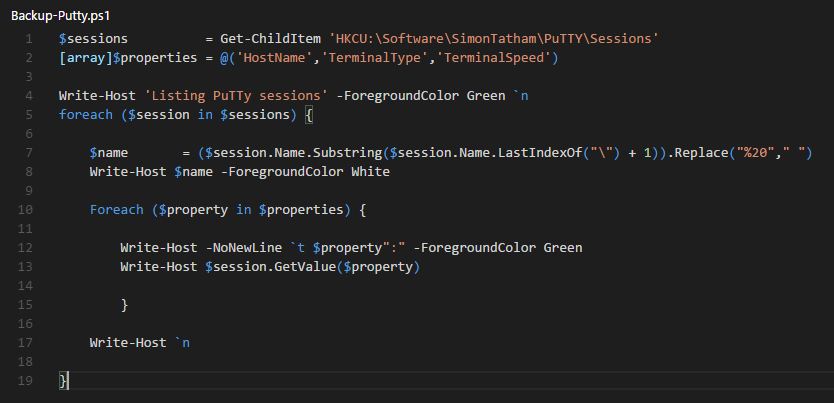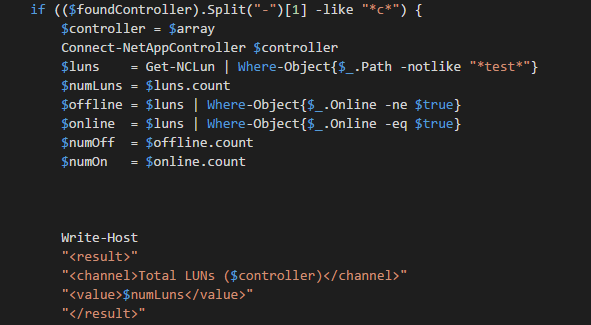Calculating Standard Deviation
What a weekend! It's the tail end of a Sunday here, but it feels like several days have gone by. It all started with Friday night when my apartment building caught on fire. Apparently someone here didn't think it was a good idea to clear out lint from the dryer. Even though I live several stories under said person, I will have to vacate my apartment on Monday due to water damage from the sprinklers.
With all this going on, I figured why not write some PowerShell! My girlfriend has been asking me to write a script/function to help her out with calculating standard deviation in a quick fashion (preferably 10 key input). So here we are.
In this post you'll find
Math
I'm not the best at math, I'll admit that up front. My girlfriend is good at it, so she helped me with the math and I filled in the PowerShell gaps. What you see is the outcome from both endeavors.
Script Explanation
I used a few different things in PowerShell to complete this task.
I declared a [decimal[]] array in order to get decimal values and ensure numbers are entered.
param( [Parameter(Mandatory=$true)] [decimal[]]$value )
To get some simple error checking, I used an if statement to see if it indeed matches a digit (probably overkill since I used [decimal[]]), but also to ensure the count was greater than 1.
if ($value -match '\d+' -and $value.Count -gt 1) {
I then declare $avgCount, and use Measure-Object to get the average, and select the Average and Count properties.
$avgCount = $value | Measure-Object -Average | Select Average, Count
After that I use a ForEach loop to iterate through all the number and do some math!
ForEach($number in $value) { $newNumbers += [Math]::Pow(($number - $avgCount.Average), 2) }
The above code takes each number in the array, get the number minus the average to the power of 2, and then adds it to the variable $newNumbers.
I then finish the calculation and store it in the variable $stdDev.
$stdDev = [math]::Sqrt($($newNumbers / ($avgCount.Count - 1)))
Once I had this information, I created an array and object. I added properties to it so I could show the original numbers used, the result, and the result rounded to different decimal places.
I then return that object array with sorting applied and formatted as a list.
[System.Collections.ArrayList]$formattedObjectArray = @() $formattedProperty= @{'Standard Deviation' = $stdDev} $formattedProperty += @{'Rounded Number (2 decimal)' = [Math]::Round($stdDev,2)} $formattedProperty += @{'Rounded Number (3 decimal)' = [Math]::Round($stdDev,3)} $formattedProperty += @{'Original Numbers' = $($value -join ",")} #Create the object we'll add to the array, with the properties set above $fpO = New-Object psobject -Property $formattedProperty #Add that object to this array $formattedObjectArray.Add($fpO) | Out-Null #Return the array object with the selected objects defined, as well as formatting. Return $formattedObjectArray | Select-Object 'Original Numbers','Standard Deviation','Rounded Number (2 decimal)','Rounded Number (3 decimal)' | Format-List
To be sure this can be used a standalone function, or as script, I declared the value parameter twice. Once was at the top of the script, and the second time in the function. So this could be used as a script, I added this if statement at the bottom:
if ($value) { Get-StandardDeviation -value $value } Else { Get-StandardDeviation }
This ensures that if there is a value from the script being run with the arguments given to the value parameter, it will pass that along to the function. If not, it will simply run the function which will ask for the values. Another way to write this would have been to ask for the value and have it mandatory at the script level as well.
More math!
The [Math] static class is very handy.
You can see what the different methods are by using the following command:
[math].GetMethods() | Select-Object -ExpandProperty Name -Unique
To see more of what it can do, check out this blog post from The Scripting Guy!
Examples of it running
Here are some examples of the script in action.
Numbers after the script name, separated by a comma.
.\Get-StandardDeviation.ps1 12345,0
Numbers declared after the -Value parameter called, separated by a comma. .\Get-StandardDeviation.ps1 -Value 12345,0
Numbers declared for the -Value parameter, but using the alias of Numbers. (Advanced parameters are fun!)
.\Get-StandardDeviation.ps1 -Numbers 12345,0
Finally, the way my girlfriend wanted it coded. She wanted to input numbers in succession and then hit enter.
.\Get-StandardDeviation.ps1
Help
You can see the help for this script by using:
Get-Help .\Get-StandardDeviation.ps1 -Detailed
The Code
<# .Synopsis This script will find the standard deviation, given a set of numbers. .DESCRIPTION This script will find the standard deviation, given a set of numbers. Written by Mike Roberts (Ginger Ninja) Version: 0.5 .EXAMPLE .\Get-StandardDeviation.ps1 Using this method you will need to input numbers one line at a time, and then hit enter twice when done. -------------------------------------------------------------------------------------------------------- PS > .\Get-StandardDeviation.ps1 cmdlet Get-StandardDeviation at command pipeline position 1 Supply values for the following parameters: value[0]: 12345 value[1]: 0 value[2]: Original Numbers : 12345,0 Standard Deviation : 8729.23321374793 Rounded Number (2 decimal) : 8729.23 Rounded Number (3 decimal) : 8729.233 -------------------------------------------------------------------------------------------------------- .EXAMPLE .\Get-StandardDeviation.ps1 -value 12345,0 .LINK http://www.gngrninja.com/script-ninja/2016/5/1/powershell-calculating-standard-deviation .NOTES Be sure to enter at least 2 numbers, separated by a comma if using the -value parameter. #> [cmdletbinding()] param( [Parameter(Mandatory=$false)] [Alias('Numbers')] [decimal[]]$value ) function Get-StandardDeviation { #Begin function Get-StandardDeviation [cmdletbinding()] param( [Parameter(Mandatory=$true)] [decimal[]]$value ) #Simple if to see if the value matches digits, and also that there is more than one number. if ($value -match '\d+' -and $value.Count -gt 1) { #Variables used later [decimal]$newNumbers = $Null [decimal]$stdDev = $null #Get the average and count via Measure-Object $avgCount = $value | Measure-Object -Average | Select Average, Count #Iterate through each of the numbers and get part of the variance via some PowerShell math. ForEach($number in $value) { $newNumbers += [Math]::Pow(($number - $avgCount.Average), 2) } #Finish the variance calculation, and get the square root to finally get the standard deviation. $stdDev = [math]::Sqrt($($newNumbers / ($avgCount.Count - 1))) #Create an array so we can add the object we create to it. This is incase we want to perhaps add some more math functions later. [System.Collections.ArrayList]$formattedObjectArray = @() #Create a hashtable collection for the properties of the object $formattedProperty = @{'Standard Deviation' = $stdDev} $formattedProperty += @{'Rounded Number (2 decimal)' = [Math]::Round($stdDev,2)} $formattedProperty += @{'Rounded Number (3 decimal)' = [Math]::Round($stdDev,3)} $formattedProperty += @{'Original Numbers' = $($value -join ",")} #Create the object we'll add to the array, with the properties set above $fpO = New-Object psobject -Property $formattedProperty #Add that object to this array $formattedObjectArray.Add($fpO) | Out-Null #Return the array object with the selected objects defined, as well as formatting. Return $formattedObjectArray | Select-Object 'Original Numbers','Standard Deviation','Rounded Number (2 decimal)','Rounded Number (3 decimal)' | Format-List } else { #Display an error if there are not enough numbers Write-Host "You did not enter enough numbers!" -ForegroundColor Red -BackgroundColor DarkBlue } } #End function Get-StandardDeviation if ($value) { Get-StandardDeviation -value $value } Else { Get-StandardDeviation }
That's all there is to it. Let me know if this helped you in any way, if you have any questions or comments, or maybe perhaps a different way to calculate standard deviation via PowerShell in the comments section below!
-Ginger Ninja

